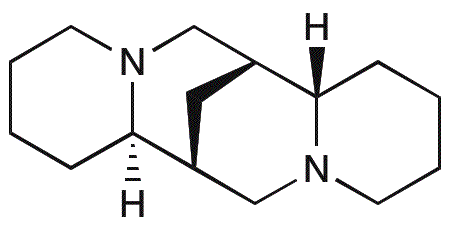(+)-Sparteine is widely utilized in research focused on:
- Asymmetric Synthesis: This compound is a valuable chiral ligand in asymmetric synthesis, helping chemists produce enantiomerically pure compounds, which are crucial in pharmaceuticals.
- Pharmaceutical Development: Its unique structure allows it to facilitate the development of new drugs by enhancing the selectivity and efficacy of active pharmaceutical ingredients.
- Organometallic Chemistry: It serves as a ligand in organometallic reactions, improving reaction rates and yields in various catalytic processes.
- Research in Neurobiology: (+)-Sparteine has been studied for its potential effects on neurotransmitter systems, making it relevant in neuropharmacology and the development of treatments for neurological disorders.
- Environmental Chemistry: The compound is also explored for its role in the synthesis of environmentally friendly materials, contributing to the development of sustainable chemical processes.
General Information
Properties
Safety and Regulations
Applications
(+)-Sparteine is widely utilized in research focused on:
- Asymmetric Synthesis: This compound is a valuable chiral ligand in asymmetric synthesis, helping chemists produce enantiomerically pure compounds, which are crucial in pharmaceuticals.
- Pharmaceutical Development: Its unique structure allows it to facilitate the development of new drugs by enhancing the selectivity and efficacy of active pharmaceutical ingredients.
- Organometallic Chemistry: It serves as a ligand in organometallic reactions, improving reaction rates and yields in various catalytic processes.
- Research in Neurobiology: (+)-Sparteine has been studied for its potential effects on neurotransmitter systems, making it relevant in neuropharmacology and the development of treatments for neurological disorders.
- Environmental Chemistry: The compound is also explored for its role in the synthesis of environmentally friendly materials, contributing to the development of sustainable chemical processes.
Documents
Safety Data Sheets (SDS)
The SDS provides comprehensive safety information on handling, storage, and disposal of the product.
Product Specification (PS)
The PS provides a comprehensive breakdown of the product’s properties, including chemical composition, physical state, purity, and storage requirements. It also details acceptable quality ranges and the product's intended applications.
Certificates of Analysis (COA)
Search for Certificates of Analysis (COA) by entering the products Lot Number. Lot and Batch Numbers can be found on a product’s label following the words ‘Lot’ or ‘Batch’.
*Catalog Number
*Lot Number
Certificates Of Origin (COO)
This COO confirms the country where the product was manufactured, and also details the materials and components used in it and whether it is derived from natural, synthetic, or other specific sources. This certificate may be required for customs, trade, and regulatory compliance.
*Catalog Number
*Lot Number
Safety Data Sheets (SDS)
The SDS provides comprehensive safety information on handling, storage, and disposal of the product.
DownloadProduct Specification (PS)
The PS provides a comprehensive breakdown of the product’s properties, including chemical composition, physical state, purity, and storage requirements. It also details acceptable quality ranges and the product's intended applications.
DownloadCertificates of Analysis (COA)
Search for Certificates of Analysis (COA) by entering the products Lot Number. Lot and Batch Numbers can be found on a product’s label following the words ‘Lot’ or ‘Batch’.
*Catalog Number
*Lot Number
Certificates Of Origin (COO)
This COO confirms the country where the product was manufactured, and also details the materials and components used in it and whether it is derived from natural, synthetic, or other specific sources. This certificate may be required for customs, trade, and regulatory compliance.


